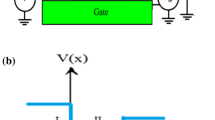Abstract
The single-electron transistor (SET) principle of operation is based on the Coulomb blockade (CB) phenomenon. The island material and associated defects have a direct impact on the range of the CB effect and the operating speed of the SET. In this research, the impact of vacancy defects on a SET-based on a carbon nanotube (CNT) is investigated. The results show that a SET with six atomic vacancies exhibits the lowest Coulomb diamond area and highest operating speed. The results also show that increasing the distance between two single vacancies decreases the Coulomb diamond area of the SET. Moreover, the location of the vacancies in the CNT and its effect on the operation of the SET are investigated. The comparison study shows that an antidote vacancy in the CNT close to the drain side results in the shortest CB range and narrowest bandgap, resulting in the CNT SET with the highest operating speed.







Similar content being viewed by others
References
KhademHosseini, V., Ahmadi, M.T., Afrang, S., Ismail, R.: Current analysis and modelling on fullerene single electron transistor at room temperature. J. Electron. Mater. 46(7), 4294–4298 (2017)
KhademHosseini, V., Dideban, D., Ahmadi, M.T., Ismail, R.: An analytical approach to model capacitance and resistance of capped carbon nanotube single electron transistor. AEU Int. J. Electron. Commun. 90, 97–102 (2018)
KhademHosseini, V., Ahmadi, M.T., Ismail, R.: Analysis and modeling of fullerene single electron transistor based on quantum dot arrays at room temperature. J. Electron. Mater. 47, 4799–4806 (2018)
KhademHosseini, V., Dideban, D., Ahmadi, M.T., Ismail, R.: Single electron transistor scheme based on multiple quantum dot islands: carbon nanotube and fullerene. ECS J. Solid State Sci. Technol. 7(10), M145–M152 (2018)
Zoghi, M., Yazdanpanah Goharrizi, A., Saremi, M.: Band gap tuning of armchair graphene nanoribbons by using antidotes. J. Electron. Mater. 46(1), 340–346 (2017)
Yazdanpanah Goharrizi, A., Zoghi, M., Saremi, M.: Armchair graphene nanoribbon resonant tunneling diodes using antidote and BN doping. IEEE Trans. Electron Devices 63(9), 3761–3768 (2016)
Saremi, M., Saremi, M., Niazi, H., Yazdanpanah Goharrizi, A.: Modeling of lightly doped drain and source graphene nanoribbon field effect transistors. Superlattices Microstruct. 60, 67–72 (2013)
Banhart, F.: Irradiation of carbon nanotubes with a focused electron beam in the electron microscope. J. Mater. Sci. 41(4), 4505–4511 (2006)
Gülseren, O., Yildirim, T., Ciraci, S.: Systematic ab initio study of curvature effects in carbon nanotubes. Phys. Rev. B 65, 153405 (2002)
Mawhinney, D.B., Naumenko, V., Kuznetsova, A., Yates, J.T., Smalley, R.E.: Surface defect site density on single walled carbon nanotubes by titration. Chem. Phys. Lett. 324, 213–216 (2000)
Hashimoto, A., Suenaga, K., Gloter, A., Urita, K., Iijima, S.: Direct evidence for atomic defects in graphene layers. Nature 430, 870 (2004)
Tien, L.G., Tsai, C.H., Li, F.Y., Lee, M.H.: Influence of vacancy defect density on electrical properties of armchair single wall carbon nanotube. Diam. Relat. Mater. 17, 563–566 (2008)
Lee, A.T., Kang, Y.J., Chang, K.J.: Transport properties of carbon nanotubes: effects of vacancy clusters and disorder. J. Phys. Chem. C 116, 1179–1184 (2012)
Rocha, A.R., Padilha, J.E., Fazzio, A., da Silva, A.J.R.: Transport properties of single vacancies in nanotubes. Phys. Rev. B 77, 153406 (2008)
Yu-Pin, L., Li-Gan, T., Chuen-Horng, T., Ming-Hsien, L., Feng-Yin, L.: Dependence of the electrical properties of defective single-walled carbon nanotubes on the vacancy density. Chin. Phys. B 20(8), 087303 (2011)
Benramache, S., Belahssen, O., Temam, H.B.: Effect of band gap energy on the electrical conductivity in doped ZnO thin film. J. Semicond. 35(7), 073001 (2014)
Talbo, V., Galdin-Retailleau, S., Valentin, A., Dollfus, P.: Physical simulation of silicon-nanocrystal-based single-electron transistors. IEEE Trans. Electron Devices 58(10), 3286 (2011)
Sée, J., Dollfus, P., Galdin, S., Hesto, P.: From wave-functions to current-voltage characteristics: overview of a Coulomb blockade device simulator using fundamental physical parameters. J. Comput. Electron. 5(1), 35–48 (2006)
Lientsching, G., Weymann, I., Hadley, P.: Simulating hybrid circuits of single-electron transistors and field-effect transistors. Jpn. J. Appl. Phys. 42, 6467–6472 (2003)
Kumar Sinha, P., Sankaranarayanan, S.: Single electron transistor and its simulation methods. Int. J. Eng. Dev. Res. 2(2), 1907–1925 (2014)
Atomistic Toolkit is licensed software. https://quantumwise.com/products. Accessed Nov 2018
Grabert, H., Devoret, M.H.: Single Charge Tunneling: Coulomb Blockade Phenomena in Nanostructures. Springer, Berlin (1992)
KhademHosseini, V., Ahmadi, M.T., Afrang, S., Ismail, R.: Analysis and simulation of coulomb blockade and coulomb diamonds in fullerene single electron transistors. J. Nanoelectron. Optoelectron. 13, 138–143 (2018)
Howlader, A.H., Islam, M.S., Tanaka, S., Makino, T., Hashimoto, A.: Vacancy and curvature effects on the phonon properties of single wall carbon nanotube. Jpn. J. Appl. Phys. 57(2S2), 02CB08 (2018)
Amjadipour, M., Viet Dao, D., Motta, N.: Vibration analysis of initially curved single walled carbon nanotube with vacancy defect for ultrahigh frequency nanoresonators. Microsyst. Technol. 22(5), 1115–1120 (2016)
Acknowledgements
This research was supported by the University of Kashan under the supervision of Dr. Daryoosh Dideban. The authors also thank the Research Management Center (RMC) of Universiti Teknologi Malaysia (UTM) for providing an excellent research environment for this simulation research using Atomistix ToolKit and to complete this work.
Author information
Authors and Affiliations
Corresponding author
Rights and permissions
About this article
Cite this article
Khademhosseini, V., Dideban, D., Ahmadi, M.T. et al. The impact of vacancy defects on the performance of a single-electron transistor with a carbon nanotube island. J Comput Electron 18, 428–435 (2019). https://doi.org/10.1007/s10825-018-01290-3
Published:
Issue Date:
DOI: https://doi.org/10.1007/s10825-018-01290-3




